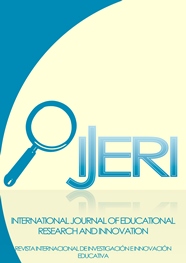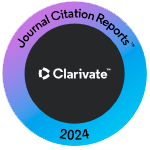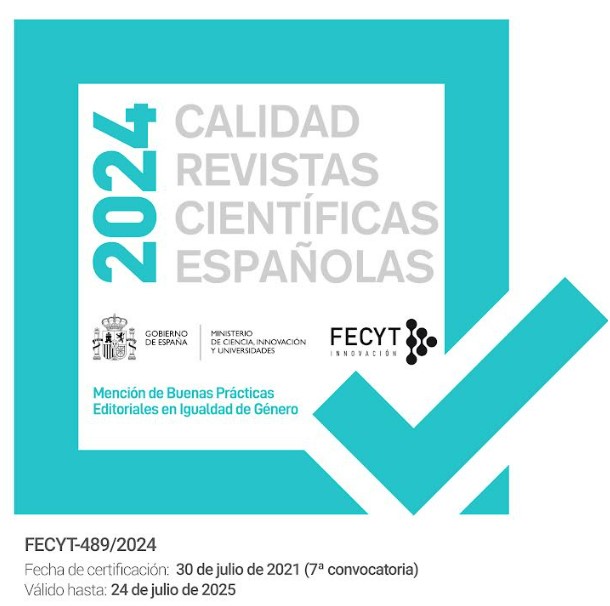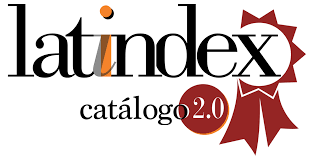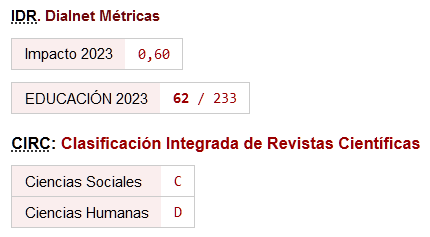Hacia un planteamiento interdisciplinar en la iniciación a la modelización económica en el Bachillerato: una propuesta en torno a la derivada y el análisis marginal
DOI:
https://doi.org/10.46661/ijeri.4701Palabras clave:
Modelos económicos, análisis marginal, función derivada, objeto virtual de aprendizaje, interdisciplinariedadResumen
En este trabajo se describe un objeto virtual de aprendizaje (OVA) elaborado bajo una perspectiva interdisciplinar que abarca las materias de Economía y Matemáticas aplicadas a las Ciencias Sociales, correspondientes ambas a la modalidad de Humanidades y Ciencias Sociales del Bachillerato. Dicho OVA está constituido por una secuencia de construcciones elaboradas con el software Geogebra y organizadas en torno al concepto matemático de función derivada y su papel como herramienta básica en la modelización económica (asociado fundamentalmente a lo que suele denominarse análisis marginal).
La propuesta se realiza con la intención de ejemplificar el tipo de materiales y actividades que podrían diseñarse y utilizarse de una manera integradora por parte del profesorado de ambas materias. Desde el punto de vista de la docencia de la economía, se considera que este tipo de planteamientos facilitaría la transferencia de los conocimientos de matemáticas al ámbito de la modelización económica, lo que resulta especialmente relevante en relación con la finalidad propedéutica del Bachillerato. Desde el de la docencia de las matemáticas, tanto la investigación relacionada con su didáctica como el propio currículo de la materia para la Educación Secundaria Obligatoria (ESO) y el Bachillerato, reflejan la importancia de incluir la modelización, no sólo por su interés como contenido, sino también por su función vehicular en tanto que facilitadora del aprendizaje de los conceptos matemáticos.
Descargas
Citas
Al-Salami, M.K., Makela, C.J. & De Miranda, M.A. (2017). Assessing changes in teachers’ attitudes toward interdisciplinary STEM teaching. International Journal of Technology and Design Education, 27(1), 63-88 (2017). DOI: https://doi.org/10.1007/s10798-015-9341-0
Arango, J., Gaviria, D. & Valencia, A. (2015). Differential calculus teaching through virtual learning objects in the field of management sciences. Procedia-Social and Behavioral Sciences, 176, 412-418. DOI: https://doi.org/ 10.1016/j.sbspro.2015.01.490
Arbain, N. & Shukor, N.A. (2015). The effects of Geogebra on students achievement. Procedia-Social and Behavioral Sciences, 172, 208-214. DOI: https://doi.org/10.1016/j.sbspro.2015.01.356
Área-Moreira, M. (2009). La sociedad de la información, las tecnologías y la educación. En M. Área-Moreira (Ed.). Introducción a la tecnología educativa. Tenerife. Universidad de La Laguna.
Ariza, A., Llinares, S. & Valls, J. (2015). Students’ understanding of the function-derivative relationship when learning economic concepts. Mathematics Education Research Journal, 17(4), 615-635. DOI: https://doi.org/10.1007/s13394-015-0156-9
Arnold, I. J. M., & Straten, J. T. (2012). Motivation and math skills as determinants of first-year performance in economics. The Journal of Economic Education, 43(1), 33-47. DOI: https://doi.org/10.1080/00220485.2012.636709
Artigue, M. (2013). L’impact curriculaire des technologies sur l’éducation mathématique. Cuadernos de Investigación y Formación en Educación Matemática, 8(11), 295-305. DOI: https://doi.org/10.36397/emteia.v4i1.2236
Ballard, C. L. & Johnson, F. (2004). Basic math skills and performance in an introductory economics class. The Journal of Economic Education, 35(1), 3-23. DOI: https://doi.org/10.3200/JECE.35.1.3-23
Blomhøj, M. (2019). Towards integration of modelling in secondary mathematics teaching. En G.A. Stillman y J.P. Brown (Eds.). Lines of Inquiry in Mathematical Modelling Research in Education, pp. 37-52. Suiza: Springer. DOI: https://doi.org/10.1007/978-3-030-14931-4_3
Blum, W. (2015). Quality teaching of mathematical modelling: What do we know, what can we do? En S.J. Cho (Ed.). The Proceedings of the 12th International Congress on Mathematical Education (pp. 73-96). Springer International Publishing. DOI: https://doi.org/10.1007/978-3-319-12688-3_9
Blum, W., & Ferri, R. B. (2009). Mathematical modelling: Can it be taught and learnt? Journal of Mathematical Modelling and Application, 1(1), 45-58.
Brady, C. (2018). Modelling and the representational imagination. ZDM - Mathematics Education, 50(1-2), 45-59. DOI: https://doi.org/10.1007/s11858-018-0926-4
Brante, G. & Brunosson, A. (2014). To double a recipe-interdisciplinary teaching and learning of mathematical content knowledge in a home economics setting. Education Inquiry, 5(2), 301-318. DOI: https://doi.org/10.3402/edui.v5.23925
Bray, A. & Tangney, B. (2017). Technology usage in mathematics education research. A systematic review of recent trends. Computers & Education, 114, 255-273. DOI: https://doi.org/10.1016/j.compedu.2017.07.004
Cabrera-Medina, J.M., Sánchez-Medina, I.I. & Rojas-Rojas, F. (2016). Uso de objetos virtuales de aprendizaje OVAS como estrategia de enseñanza-aprendizaje inclusivo y complementario a los cursos teóricos-prácticos. Una experiencia con estudiantes del curso física de ondas. Revista Educación en Ingeniería, 11(22), 4-12.
Carlson, M., Jacobs, S., Coe, E., Larsen, S. & Hsu, E. (2002). Applying covariational reasoning while modeling dynamic events: A framework and a study. Journal for Research in Mathematics Education, 33(5), 352-378. DOI: https://doi.org/10.2307/4149958
Carlson, M., Oehrtman, M., & Engelke, N. (2010). The precalculus concept assessment: A tool for assessing students’ reasoning abilities and understandings. Cognition and Instruction. 28(2), 113-145. DOI: https://doi.org/10.1080/07370001003676587
Casasús-Estellés, T., Ivars-Escortell, A. & López-Rodríguez, M.I. (2018). Present and future of the e-learning in economics schools and faculties. Multidisciplinary Journal for Education, Social and Technological Sciences, 5(1), 44-64.
Chevallard, Y. (2007). Passé et présent de la théorie anthropologique du didactique. En L. Ruiz-Higueras, A. Estepa y F.J. García (Eds.). Sociedad, Escuela y Matemáticas. Aportaciones de la Teoría Antropológica de la Didáctica, pp. 705-746. Jaén: Servicio de publicaciones de la Universidad de Jaén.
Duval, R. (1993). Registres de représentation sémiotique et fonctionnement cognitif de la pensée. Annales de Didactique et de Sciences Cognitives, 5, 37-65. IREM de Strasbourg, Francia.
Duval, R. (2006). A cognitive analysis of problems of comprehension in a learning of Mathematics. Educational Studies in Mathematics, 61, 103-131. DOI
https://doi.org/10.1007/s10649-006-0400-z
Freudenthal, H. (2002). Revisiting Mathematics Education : China Lectures. Norwell: Kluwer Academic Publishers.
Galbraith, P., & Stillman, G. (2006). A framework for identifying student blockages during transitions in the modelling process. ZDM - International Journal on Mathematics Education, 38(2), 143-162. DOI: https://doi.org/10.1007/BF02655886
Geiger, V., Faragher, R. & Goos, M. (2010). CAS-enabled technologies as ‘agents provocateurs’ in teaching and learning mathematical modelling in secondary school classrooms. Mathematics Education Research Journal. 22(2), 48-68. DOI:
https://doi.org/10.1007/BF03217565
Gravemeijer, K., & Doorman, M. (1999). Context problems in realistic mathematics education: A Calculus Course as an Example. Educational Studies in Mathematics, 39, 111-129. DOI: https://doi.org/10.1023/A:1003749919816
Kaiser G. & Brand S. (2015) Modelling competencies: Past development and further perspectives. En G. Stillman, W. Blum, M. Salett Biembengut (Eds.). International Perspectives on the Teaching and Learning of Mathematical Modelling, pp. 129-149. Cham: Springer.
Katzner, D.W. (2003). Why mathematics in economics? Journal of Post Keynesian Economics, 25(4), 561-574.
Klaassen, R.G. (2018). Interdisciplinary education: a case study, European Journal of Engineering Education, 43(6), 842-859, DOI: https://doi.org/10.1080/03043797.2018.1442417
Kllogjeri, P. (2010). GeoGebra: A global platform for teaching and learning math together and using the synergy of mathematicians. En M.D. Lytras, P. Ordonez De Pablos, D. Avison, J. Sipior, Q. Jin, W. Leal Filho, L. Uden, M. Thomas, S. Cervai & D.G. Horner (Eds.). Technology Enhanced Learning. Quality of Teaching and Educational Reform. Communications in Computer and Information Science, 73. Springer, Berlín, Heidelberg.
Lesh, R., & Doerr, H. M. (2003). Models and modeling perspectives on mathematics problem solving, learning and teaching. En R. Lesh & H. M. Doerr (Eds.). Beyond Constructivism: Models and modeling perspectives on mathematics problem solving, learning and teaching, pp. 3-58. Mahawah, NJ: Lawrence Earlbaum.
Maaß, K. (2006). What are modelling competencies? ZDM - International Journal on Mathematics Education, 38(2), 113-142. DOI: https://doi.org/10.1007/BF02655885
Marín-Díaz, V., Burgos-Mellado, S. & López-Pérez, M. (2018). Formación de docentes para la inclusión digital desde el plan escuela 2.0: estudio de un caso. International Journal of Educational Research and Innovation (IJERI), 10, 274-298.
Ministerio de Educación, Cultura y Deporte de España (MECD). (2013). Marcos y pruebas de evaluación de PISA 2012: Matemáticas, Lectura y Ciencias. https://www.educacionyfp.gob.es/dctm/inee/internacional/pisa2012/marcopisa2012.pdf?documentId=0901e72b8177328d
Mkhatshwa, T.P. (2019). Students’ quantitative reasoning about an absolute extrema optimization problem in a profit maximization context. International Journal of Mathematical Education in Science and Technology, 50(8), 1105-1127. DOI: https://doi.org/10.1080/0020739X.2018.1562116
Mora-Vicarioli, F. (2012). Learning objects: The importance of its use in the virtual education. Revista Calidad en la Educación Superior, 3(1), 104-118.
Morales, L., Gutiérrez, L. & Ariza, L. (2016). Guía para el diseño de objetos virtuales de aprendizaje (OVA). Aplicación al proceso de enseñanza-aprendizaje del área bajo la curva de cálculo integral. Revista Científica General José María Córdova, 14(18), 127-147.
Niss, M. (2003). Mathematical competencies and the learning of mathematics: The Danish Kom Project. Proceedings of the 3rd Mediterranean Conference on Mathematical Education, 115-124.
Pollak, H. O. (1979). The interaction between mathematics and other school subjects. En UNESCO (Eds.). New Trends in Mathematics Teaching IV, pp. 232-248. París.
Rai, B.K., So, C.K. & Nicholas, A. (2010). A primer on mathematical modelling in Economics. Journal of Economic Surveys. 26(4), 594-615. DOI:
https://doi.org/10.1111/j.1467-6419.2010.00655.x
Real Decreto 1179/1992, de 2 de octubre, por el que se establece el currículo del Bachillerato (BOE-A-1992-23406). https://www.boe.es/buscar/doc.php?id=BOE-A-1992-23406
Real Decreto 1105/2014, de 26 de diciembre, por el que se establece el currículo básico de la Educación Secundaria Obligatoria y del Bachillerato. https://www.boe.es/boe/dias/2015/01/03/pdfs/BOE-A-2015-37.pdf
Roorda, G., Vos, P. & Goedhart, M. (2007). 5.8-The concept of the derivative in modelling and applications. En C., Haines, C., Galbraith, P., Blum, W. & S. Khan (Eds.). Mathematical Modelling. Education, Engineering and Economics-ICTMA 12, pp. 288-293. Woodhead Publishing. DOI: https://doi.org/10.1533/9780857099419.5.288
Sfard, A. (1991). On the dual nature of mathematical conceptions: Reflections on processes and objects as different sides of the same coin. Educational Studies in Mathematics, 22(1), 1-36. DOI: https://doi.org/10.1007/BF00302715
Thompson, P. W. & Carlson, M. (2017). Variation, covariation and functions: Foundational ways of thinking mathematically. En Cai, J. (Ed.). Compendium for research in Mathematics Education, pp. 421-456. Reston, VA: National Council of Teachers of Mathematics.
Tur, G.I. & Shakhovnina, N.V. (2015). Applications as a way of implementation of interdisciplinary connections of mathematical and economic disciplines. Science and Education a New Dimension. Pedagogy and Psychology,37(75), 14-16.
Wiley, D.A. (2000). Connecting learning objects to instructional design theory: A definition, a metaphor, and a taxonomy. En D.A. Wiley (Ed.). The Instructional Use of Learning Objects: Online Version.
Zandieh, M. (2000). A theoretical framework for analyzing student understanding of the concept of derivative. En Research in Collegiate Mathematics Education IV, 8, pp. 103-127. Arizona: Conference Board of the Mathematical Science.
Descargas
Publicado
Cómo citar
Número
Sección
Licencia
Derechos de autor 2021 María Gutiérrez-Portilla, Paula Gutiérrez-Portilla, Pedro Álvarez

Esta obra está bajo una licencia internacional Creative Commons Atribución-NoComercial-SinDerivadas 4.0.

